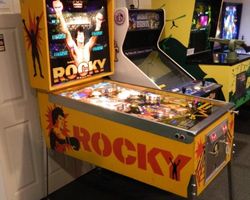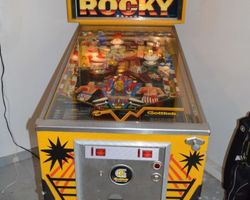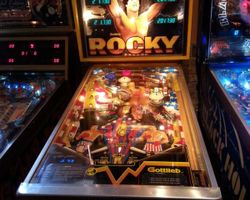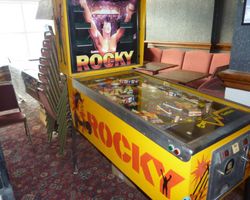Rocky
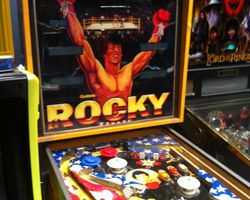
Average Prices: USD $1,100 to $4,000
Produced: September, 1982
Production Run: 1,504 units
Machine Type: Solid State Electronic
MPU: Gottlieb System 80A
Players: 4
Design by: John Trudeau
Art by: David Moore
D. Gottlieb & Co. presented "Rocky" to pinball players in September 1982, a solid-state electronic widebody machine that leveraged the immense popularity of the "Rocky" film franchise. This machine was a significant release for Gottlieb, arriving as the second game to utilize their advanced System 80A hardware, following closely on the heels of "Devil's Dare." Its development was intertwined with the movie's ongoing success, aiming to capture the essence of boxing and the underdog spirit that defined the films.
The design of "Rocky" was primarily handled by John Trudeau, with the distinctive artwork crafted by David Moore. Their collaboration resulted in a machine that aimed to bring the cinematic experience to the pinball playfield. A particularly interesting aspect of the machine's artistic development revolved around the backglass. The artwork, depicting a triumphant Rocky, underwent direct approval from Sylvester Stallone himself, who requested revisions to ensure Rocky's face was not shown as overly "beat-up." This attention to detail highlights the collaboration involved in licensed themes. David Moore also included a subtle nod to himself and Trudeau within the backglass crowd art, a common practice among pinball artists to personalize their work. Production of "Rocky" was limited to 1,504 units, making it a relatively rare title in the vast landscape of pinball history. This limited run contributes to its collectibility and mystique among enthusiasts today.
"Rocky" stands out with its unique playfield features, designed to immerse players in a boxing match. The machine boasts five flippers, a defining characteristic that immediately distinguishes it from most other pinball tables. Four pop bumpers propel the ball with unpredictable force, contributing to the chaotic energy of a boxing ring. The inclusion of eleven drop targets, arranged in a five-bank and two three-bank sets, provides numerous scoring opportunities and challenges players to hit specific areas of the playfield. A spinning target adds another dynamic element, rewarding accurate shots with variable points. A ball kicker lane located below the main flippers ensures balls are quickly returned to action after certain shots, maintaining play momentum. The overall widebody design provides an expansive playfield, allowing for a more complex layout and offering greater visual impact, contributing to the machine’s imposing presence.
The playfield of "Rocky" is laid out to simulate the ebb and flow of a boxing match. The extensive widebody design allows for a multi-tiered approach to gameplay, with targets and shots spread across a broad canvas. The five-flipper configuration is a central element, with two standard lower flippers and an additional pair of flippers positioned further up the playfield, creating distinct upper and lower play areas. A fifth, smaller flipper is strategically placed in the lower-right quadrant, just above the right outlane, offering a nuanced save or a tricky shot opportunity. The numerous drop targets are integrated into lanes and features, demanding precision to clear them for bonus points or to activate game modes. The playfield artwork by David Moore effectively captures the gritty atmosphere of a boxing arena, with vibrant colors and dynamic depictions of fighters and spectators. Lighting is used to highlight scoring opportunities and guide the player's eye towards active targets, enhancing the overall aesthetic and gameplay experience.
Gameplay in "Rocky" is structured around advancing through boxing "rounds" and achieving knockouts, mirroring the theme. The primary objective is to build up points and complete specific shot sequences to trigger the "10 count" sequence, a core gameplay mechanic that provides a sense of progression and excitement. Players must strategically use the five flippers to navigate the ball through various lanes, hit drop targets, and activate features. The machine's scoring system rewards combinations and sustained play, encouraging players to master the unique flipper layout. The widebody format, combined with the multiple flippers, creates a distinct play experience, often described as challenging due to the potential for quick drains if shots are not precise. Success hinges on adapting to the unusual flipper placement and developing new strategies for ball control and target acquisition. The sounds, including the roar of the crowd and the bell at the end of rounds, further immerse the player in the boxing theme.
"Rocky" elicits a range of opinions within the pinball community, often described as a machine with a polarizing reputation. Its strengths are frequently cited as its distinctive four-flipper layout (referring to the two main sets) which offers a truly unique gameplay experience, diverging significantly from conventional designs. Enthusiasts often praise the effective integration of the "Rocky" theme, feeling that the game successfully captures the essence of the movies, particularly for fans of the franchise. Some find the gameplay, once mastered, to be highly addictive and rewarding, with the "10 count" sequence specifically highlighted as a gratifying objective. The rarity of the 1,504 production units also contributes to its appeal among collectors, fostering a sense of nostalgia for a machine that is not commonly encountered.
However, "Rocky" also receives criticism, particularly regarding its backglass art, which is often described as muddy or depicting characters that appear distorted. The gameplay itself is sometimes characterized as clunky, lacking the fluid flow found in other machines, and the unique flipper layout, while celebrated by some, is a point of frustration for others. Many players find the flippers difficult to control, leading to frequent and often unexpected ball drains, making the game challenging to master. The fifth flipper, in particular, is sometimes seen as ineffective or difficult to incorporate into a coherent strategy. Furthermore, like many solid-state machines of its era, "Rocky" relies heavily on proper maintenance, including fresh rubbers and strong flippers, to ensure an enjoyable and responsive experience. When these elements are not optimal, the game's perceived clunkiness can be exacerbated. Despite these criticisms, "Rocky" holds a significant place in pinball history due to its experimental design and its status as an early Gottlieb System 80A widebody. Its influence is less about direct replication in future designs and more about its contribution to the diversity of pinball layouts, demonstrating Gottlieb's willingness to innovate and experiment with playfield configurations. Its distinctive character ensures it remains a topic of discussion among pinball enthusiasts, valued for its unconventional approach and the challenge it presents.
Sponsored Links
 Ebay Listings
Ebay Listings
 Auction Results
Auction Results
| Cost | Location | Date |
|---|---|---|
| USD $7,950 |  South Carolina, United States South Carolina, United States |
22 November, 2020 |
| USD $3,150 |  Greece Greece |
08 October, 2020 |
| USD $5,500 |  Texas, United States Texas, United States |
06 March, 2019 |
| EUR €3,200 |  Nordrhein-Westfalen, Germany Nordrhein-Westfalen, Germany |
27 January, 2017 |
| EUR €3,500 |  Nordrhein-Westfalen, Germany Nordrhein-Westfalen, Germany |
24 December, 2016 |
| USD $3,000 |  North Carolina, United States North Carolina, United States |
03 December, 2016 |
| USD $4,450 |  California, United States California, United States |
12 May, 2016 |
| USD $12,995 |  Pennsylvania, United States Pennsylvania, United States |
04 September, 2014 |
| USD $4,800 |  Michigan, United States Michigan, United States |
23 August, 2014 |
| USD $2,300 |  New Jersey, United States New Jersey, United States |
19 July, 2014 |


Private Policy · Search Website · Contact Us
As an eBay Partner, we may earn a commission from qualifying purchases made through links on this site, at no additional cost to you.
All trademarks and copyrighted materials remain property of their respective owners. All other content copyright 2007 - 2025 Pinpedia.



